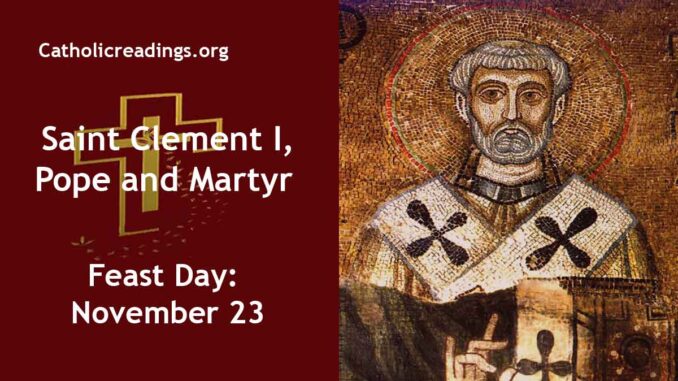Pope Clement I is also known as St Clement of Rome. He was born in 35 AD in the Roman Empire.
He became the Pope and Bishop of Rome from 88 AD until 99 AD when he died in Greece during the reign of Roman Emperor Trajan.
He is the first Apostolic Father of the Church having been consecrated by St Peter the Apostle himself.
We celebrate his feast day on November 23 every year in the Catholic Church.
Pope Clement I is the Patron Saint of Sailors, seamen, mariners or seafarers, Stone-cutters, and Angono, Rizal, Philippines.
| St Clement I, Pope Biography | |
|---|---|
 |
|
| Date of Birth | 35 AD |
| Place of Birth | Roman Empire |
| Profession | Pope and Bishop of Rome |
| Place of Work | Rome, Italy |
| Date of Death | 99 AD |
| Place of Death | Crimea, Ukraine/Russia |
| Feast Day | November 23 |
| Canonization | Pre-Congregation |
| Patron Saint of |
|
Pope Clement I Life History
Pope Clement I is well known for writing the First Epistle of Clement or 1 Clement to the Christian Congregation in Corinth after a dispute arose between the laity and the clergy.
The laity had deposed several members of the clergy and Pope Clement reiterated the obedience of the Church’s authority and maintenance of order. His letter was read in the Church to affirm the apostolic authority of the clergy.
This letter wielded so much authority and almost reached canonical status for it was invoked many times by many Christians in the 3rd and 4th centuries.
There emerged the Second Epistle of Clement and thereafter other letters that were thought to be authored by Pope Clement. However, they were later deemed not to have been written by him.
Pope Clement may have been the third successor of St Peter and is thought to be the Clement mentioned by St Paul in his Letter to the Philippians (Philippians 4:3).
3 Yes, and I ask you also, my true yokemate, to help them, for they have struggled at my side in promoting the gospel, along with Clement and my other co-workers, whose names are in the book of life.
Philippians 4:3
According to Tertullian, an early Christian author from Carthage, Pope Clement was the immediate successor of St Peter. But according to Irenaeus and Eusebius, he became the pope after Linus and Anacletus.
The legend of Pope Clement’s death and martyrdom goes like this. During the reign of Emperor Trajan, there arose sedition pitying the masses in Rome and the Christians, especially Pope Clement.
Pope Clement was arrested and the emperor banished him and condemned him to hard labour in the marble quarries in Pontus. Here he met with many fellow Christians who were convicts too whom he encouraged and comforted.
At that place, there was an acute shortage of water and the convicts were forced to walk a long distance of over six miles to get that precious commodity.
One day, while working he looked up the hill and saw a lamb scratching the ground with its hoof. He took that as a sign from God that that place has water.
He went there, took his axe, struck the ground, and dug it, and a stream of fresh water came out. Seeing this miracle, many pagans and fellow convicts converted to Christianity in large numbers.
Death
The conversion of pagans in large numbers came with a price to pay. As punishment, Pope Clement was sentenced to death.
An anchor was tied around his neck and thrown into the Black Sea where he drowned and died as a martyr.
Relics
The remains of Pope Clement were recovered and buried in Crimea at the site where The Inkerman Monastery of St Clement is located.
Many centuries later, some relics were translated to Rome by St Cyril a few years before he died in 869 AD. They are now enshrined at the Minor Basilica of Saint Clement in Rome, Italy.
Some other relics are claimed to be in Chersonesus, (Cherson) in the southwestern part of the Crimean Peninsula, and others in the Kyiv Monastery of the Caves (Kyiv-Pechersk Lavra or Kyivo-Pechers’ka Lavra) in Ukraine.
St Clement I, Pope Feast Day
We celebrate his feast day on November 23 every year in the Catholic Church.
Related Links
Powered By SEO Experts
Follow @ReadingCatholic
